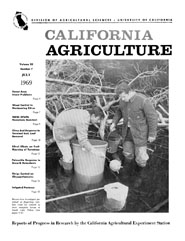


University of California
California Agriculture
|
|||
|
|||

Cover:
Researchers investigate potential of fingerling rainbow trout for control of snow mosquito larvae at South I,ake Tahoe.
July 1969
Volume 23, Number 7 |
|||
|
University of California, 1301 S. 46th St., Bldg. 478 Richmond, CA
|